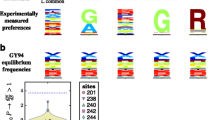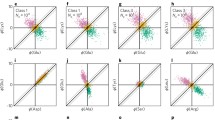Summary
The population dynamics of nearly neutral mutations are studied using a single-site and a multisite model. In the latter model, the nucleotides in a sequence are completely linked and the selection schemes employed are additive, multiplicative, and additive with a threshold. Although the third selection scheme is very different from the first two, the three schemes produce identical results for a wide range of parameter values. Thus the present study provides a general theory for the population dynamics of nearly neutral mutations because the results can also be used to draw inferences about other selection schemes such as stabilizing selection and synergistic selection. It is shown that the number of slightly deleterious mutations accumulated in a sequence can be considerably larger under the multisite model than under the single-site model, particularly if the sequence is long or if the mutation rate per site is high. The results show that even a very slight selective difference between synonymous codons can produce a strong bias in codon usage. Three alternative explanations for the strong bias in codon usage in bacterial and yeast genes are considered. The implications of the present results for molecular evolution are discussed.
Similar content being viewed by others
References
Bennetzen JL, Hall BD (1982) Codon selection in yeast. J Biol Chem 257:3026–3031
Felsenstein J (1974) The evolutionary advantage of recombination. Genetics 78:737–756
Grantham R (1980) Workings of the genetic code. Trends Biochem Sci 5:327–331
Grantham R, Gautier C, Gouy M (1980) Codon frequencies in 119 individual genes confirm consistent choices of degenerate bases according to genome type. Nucleic Acids Res 8:1893–1912
Grosjean H, Fiers W (1982) Preferential codon usage in prokaryotic genes: the optimal codon-anticodon interaction energy and the selective codon usage in efficiently expressed genes. Gene 18:199–209
Ikemura T (1981) Correlation between the abundance ofEscherichia coli of the respective codons in its protein genes. J Mol Biol 146:1–21
Ikemura T (1985) Codon usage and tRNA content in unicellular and multicellular organisms. Mol Biol Evol 2:13–34
Kimura M (1968) Evolutionary rate at the molecular level. Nature 217:624–626
Kimura M (1981) Possibility of extensive neutral evolution under stabilizing selection with special reference to nonrandom usage of synonymous codons. Proc Natl Acad Sci USA 78:5773–5777
Kimura M (1983) The neutral theory of molecular evolution. Cambridge University Press, Cambridge, England
Kimura M, Ohta T (1971) Protein polymorphism as a phase of molecular evolution. Nature 229:467–469
King JL, Jukes TH (1969) Non-Darwinian evolution. Science 164:788–798
Li WH (1977) Maintenance of genetic variability under mutation and selection pressures in a finite population. Proc Natl Acad Sci USA 74:2509–2513
Li WH (1980) Rate of gene silence at duplicate loci: a theoretical study and interpretation of data from tetraploid fishes. Genetics 95:237–258
Li WH, Luo CC, Wu CI (1985) Evolution of DNA sequences. In: MacIntyre RJ (ed) Molecular evolutionary genetics. Plenum, New York, pp 1–94
Muller HJ (1964) The relation of recombination to mutational advance. Mutat Res 1:2–9
O'Brien P (1985) A genetic model with mutation and selection. Math Biosci 73:239–251
Ohta T (1974) Mutational pressure as the main cause of molecular evolution and polymorphism. Nature 252:351–354
Robertson A (1961) Inbreeding in artificial selection programmes. Genet Res 2:189–194
Robinson M, Lilley R, Little S, Emtage JS, Yarranton G, Stephens P, Millican A, Eaton M, Humphreys G (1984) Codon usage can affect efficiency of translation of genes inEscherichia coli. Nucleic Acids Res 12:6663–6671
Sharp PM, Rogers MS, McConnell DJ (1985) Selection pressures on codon usage in the complete genome of bacteriophage T7. J Mol Evol 21:150–160
Watterson GA (1977) Heterosis or neutrality. Genetics 85:789–814
Wright S (1931) Evolution in Mendelian populations. Genetics 16:97–159
Wright S (1949) Adaptation and selection. In: Jepson GL, Simpson GG, Mayr E (eds) Genetics, paleontology and evolution. Princeton University Press, Princeton, pp 365–389
Author information
Authors and Affiliations
Rights and permissions
About this article
Cite this article
Li, WH. Models of nearly neutral mutations with particular implications for nonrandom usage of synonymous codons. J Mol Evol 24, 337–345 (1987). https://doi.org/10.1007/BF02134132
Received:
Revised:
Issue Date:
DOI: https://doi.org/10.1007/BF02134132




